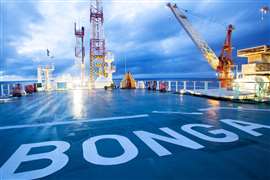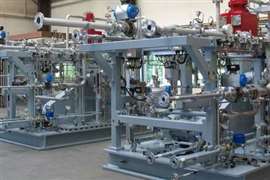IEF: Hydrogen needs ‘massive’ investment for decarbonization goals
June 13, 2022
Currently hydrogen accounts for only about one percent of the energy mix
Hydrogen will play a key role in decarbonizing the energy mix, but massive investment and development along the supply chain are needed, according to a recent report from the International Energy Forum.
The Hydrogen Market Pathways report was written by the IEF with Anne-Sophie Corbeau of the Columbia Center on Global Energy Policy. The report does not estimate, in dollar figures, the scale of the investment needed. It does outline the scope of changes needed to allow hydrogen to play a significant role in decarbonization.
While interest and momentum surrounding hydrogen has grown in recent years, the idea of using hydrogen as an energy carrier is not new – it has come in and out of fashion since the 1970’s, the report states. Yet, despite decades of interest and research, there are still many obstacles to overcome for the hydrogen market to scale-up. Currently, hydrogen accounts for only ~1% of the energy mix, is predominately produced using unabated fossil fuels, and is mainly used on-site where it is produced.
For hydrogen to play a role in the energy transition, it must be available in sufficient volumes, at a competitive cost, and with low carbon intensity associated with its supply chain.
The entire supply chain must be developed and scaled up. Different demand forecast scenarios show hydrogen consumption growing by as much as six-fold by 2050 (with low-carbon hydrogen growing by 500-600-fold). Such growth makes it increasingly plausible that hydrogen could become an internationally traded commodity in the coming decades, the report states.
Understanding the likely pathways and drivers of maturation is essential for reducing risk and attracting investor and government buy-in. For hydrogen to achieve its potential, decisive policy action will be needed, as well as significant infrastructure investment, to drive scale. Developing hydrogen will require a significant development of renewable capacity beyond what will be used to decarbonize the power sector. Large-scale hydrogen networks will be necessary to connect production and storage resources to end-users. Scaling-up the supply chain can lower supply costs, increase security, enable competitive markets, and facilitate international trade. This report first looks at the current hydrogen market and supply chain and then examines what will shape and determine market and business model development under the assumption that economics and technology evolve favorably. Next, the study examines what external contractual and regulatory support can help guide a successful scale-up.
Hydrogen is expected to play a key role in sectors where electrification doesn’t work, such as high-temperature industrial processes, heavy road transportation, and shipping, the report finds.
It says the industry must develop a new carbon intensity scale and move beyond the current over-simplified system of color designations, such as “green hydrogen” when it is made with renewable energy and “blue hydrogen” when it is made from natural gas.
Measuring and tracking carbon intensity will need to be standardized and ‘green’ certifications and guarantees of origin will be important elements enabling international trade.
Electrification, as in the case of electric vehicles, is the preferred way to decarbonize the energy sector, because low-carbon electricity can be made from sources such as nuclear, renewables or natural gas with carbon capture filters. But electrons are difficult to store and transport.
As a molecule, hydrogen has an important advantage over electrons, in that it can transfer energy over time and distances and can be stored more efficiently.
Hydrogen can unlock otherwise stranded energy assets such as remote and isolated renewable energy sites. It can connect places that have ample renewable energy resources but no effective means of delivering it to markets. Infrastructure and transportation developments will be needed to unlock these arbitrage opportunities, the report says.
The report finds that the hydrogen market is still in its infancy, and development is needed along the entire supply chain.
Low-carbon hydrogen production and utilization must increase from about 1 million tons per annum (Mtpa) today to hundreds of Mtpa by 2050. This will involve expansion and development in production, transportation, storage, and end-use.
“Scaling-up hydrogen will require new business models, pricing, contracts, regulations, standards, certificates, and policies,” the report says.
International partnerships will be an essential component of developing the hydrogen economy, providing off-take certainty, and enabling scale. Broad-based collaboration within and across industries and governments will be needed as well as a commitment to capital and sharing resources and technology, the report finds.
Despite parallels between hydrogen and other market development pathways such as liquefied natural gas, they should not be regulated in the same way, the report says.
“There is still room for innovation in hydrogen technology and business models that over-regulation could hinder. Regulation that is “fit for purpose” can help mitigate risk inherent in a new market, particularly in attracting investment,” the report states.
“A delicate balance is needed to ensure hydrogen helps in the energy transition but is also competitive and cost-effective.”
While talking about the hydrogen economy, it is important to understand that this concept goes beyond pure hydrogen, the report states. It also includes other energy carriers based on hydrogen such as ammonia, methanol, as well as synthetic methane, which are easier to transport. Ammonia could be used in shipping and is currently being tested in Japan in the power sector mixed with coal; methanol is being tested in shipping by Maersk while synthetic methane can be produced from hydrogen and captured CO2 and therefore use the current natural gas infrastructure.
Since it is technically possible to produce low-carbon hydrogen anywhere in the world, based on various energy sources ranging from wind, solar, biomass, nuclear, hydro as well as natural gas (with CCUS), countries can leverage hydrogen to diversify their energy sources and trade partners as many countries will likely become hydrogen producers and consumers. Once the market has scaled, hydrogen is less likely to be successfully weaponized by an exporter nor give a massive importing country undue market power given the number and diversity of potential hydrogen exporters. Using hydrogen to augment the energy mix can help ensure energy security.
“The current market crisis has accelerated the targets for hydrogen across the world and new large-scale projects are announced almost on a daily basis,” said IEF Secretary General Joseph McMonigle. “This report provides essential guidance to policymakers, especially as regards to regulation, carbon management and efficiency.”
MAGAZINE
NEWSLETTER

CONNECT WITH THE TEAM










